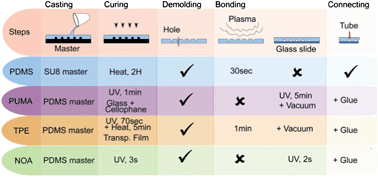Multiple methods of fabrication exist for microfluidic devices, with different advantages depending on the end goal of industrial mass production or rapid prototyping for the research laboratory. Polydimethylsiloxane (PDMS) has been the mainstay for rapid prototyping in the academic microfluidics community, because of its low cost, robustness and straightforward fabrication, which are particularly advantageous in the exploratory stages of research. However, despite its many advantages and its broad use in academic laboratories, its low elastic modulus becomes a significant issue for high pressure operation as it leads to a large alteration of channel geometry. Among other consequences, such deformation makes it difficult to accurately predict the flow rates in complex microfluidic networks, change flow speed quickly for applications in stop-flow lithography, or to have predictable inertial focusing positions for cytometry applications where an accurate alignment of the optical system is critical. Recently, other polymers have been identified as complementary to PDMS, with similar fabrication procedures being characteristic of rapid prototyping but with higher rigidity and better resistance to solvents; Thermoset Polyester (TPE), Polyurethane Methacrylate (PUMA) and Norland Adhesive 81 (NOA81). In this review, we assess these different polymer alternatives to PDMS for rapid prototyping, especially in view of high pressure injections with the specific example of inertial flow conditions. These materials are compared to PDMS, for which magnitudes of deformation and dynamic characteristics are also characterized. We provide a complete and systematic analysis of these materials with side-by-side experiments conducted in our lab that also evaluate other properties, such as biocompatibility, solvent compatibility, and ease of fabrication. We emphasize that these polymer alternatives, TPE, PUMA and NOA, have some considerable strengths for rapid prototyping when bond strength, predictable operation at high pressure, or transitioning to commercialization are considered important for the application.


 Please wait while we load your content...
Please wait while we load your content...